Maintaining high service levels: A guide for call centers

VP of Customer Experience
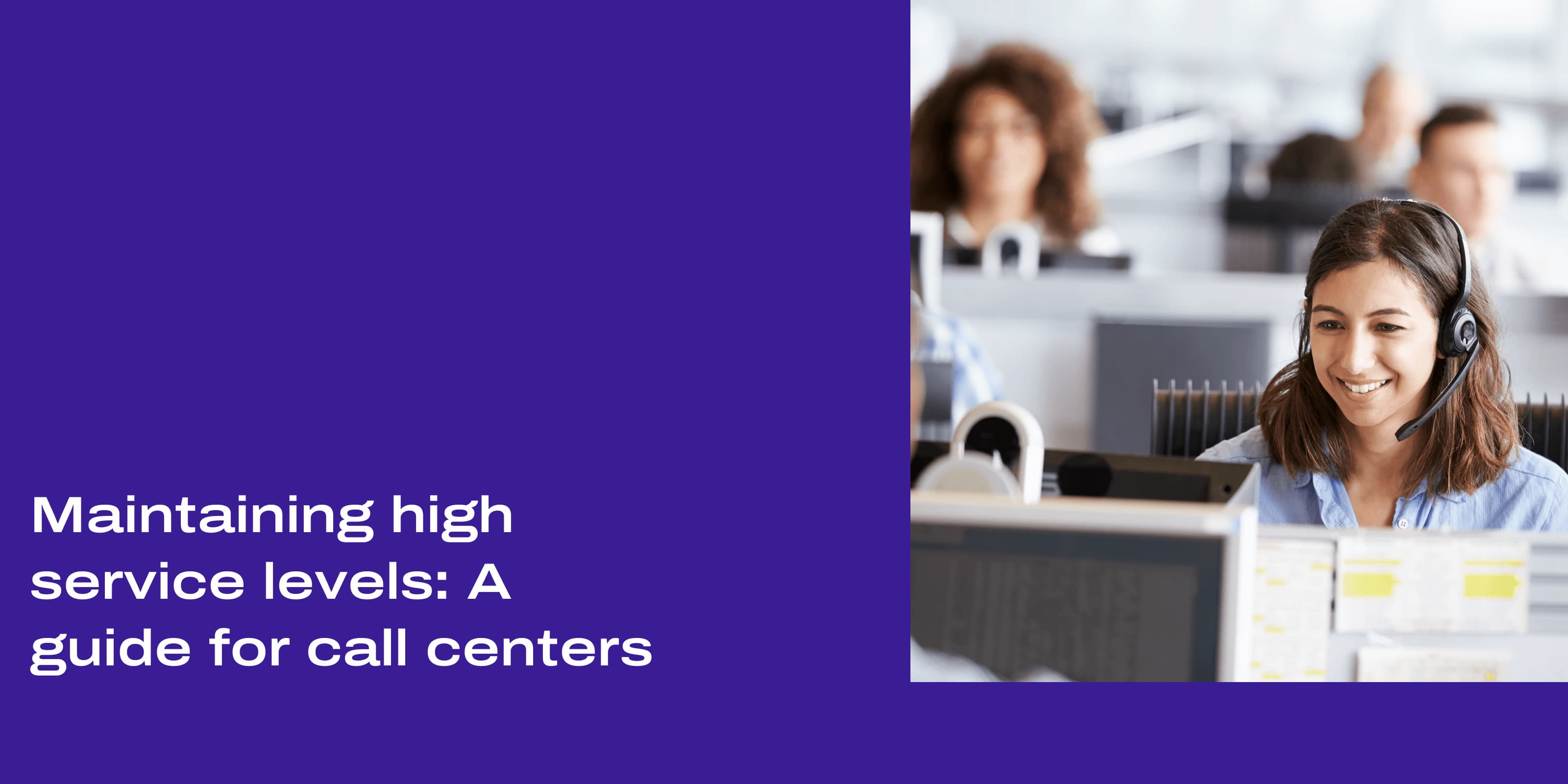
Tags
Share
When you’re thinking about how to run an effective contact center or call center, certain questions often pop up.
What is the average handle time? What are our call avoidance rates? Which call center optimization strategies should we implement?
These are all good questions to ask, but how would you know where to begin if you didn’t know the average industry standards (or at the very least, your own performance benchmarks to compare against)?
Even if you measured your handle time or the amount of calls picked up within a given time rigorously, you’d find it tricky to really gauge how good your service level agreements (SLAs) are without a rough idea of the industry standards.
👉Dialpad tip:
A call center’s best weapon for achieving good service level standards is its communications or contact center platform. This software will help you not only be responsive to customers and callers, but also give you useful data and analytics on your SLAs. We’ll get into this more in just a bit.
Read on to learn how you can maintain and improve your contact center’s service level, as well as some key performance indicators (KPIs) to know about as you measure your SLAs.
What is the contact or call center service level metric?
Your contact center’s service level is an important indicator of your availability to customers—and how well-designed your strategy for managing customers and callers is.
Different contact centers measure this in slightly different ways. You could look at a specific metric—the percentage of calls answered within a set timeframe, for instance.
You've probably heard the oft-quoted industry standard of answering at least 80% of calls in under 20 seconds. I'll explain why this isn't the best number to look at in just a bit.
For now, let's look at a call center service level agreement, and the two parts that typically make up this concept: the “service level objective,” and the “service level.”
1. The service level objective (what you want to hit)
This is your goal—the numbers you’re trying to hit. If you want to talk about performance and measurement, you need to have a goal (in this case, a service level objective) to track your results against.
If you want to measure the number of calls your contact center takes, for example, then you could calculate this particular service level objective like this:
The percentage of calls taken ÷ target time threshold
2. The service level (what you’re actually hitting)
Once you’ve got your service level objective, you can measure your service level against it. You can measure your team’s performance during what time frames you prefer (hours, days, weeks).
For example, if you want to measure your service level in the example above, you can look at the percentage of calls your agents take in an hour, a day, or a week.
Maintaining your call center’s service levels is key to improving your customer satisfaction and customer experience. Ultimately, of course, it’s all about revenue, and in this case your goal is to increase your customers’ lifetime value. (The happier your consumers are, the more likely they are to buy your products or services on repeat.)
Our team uses Dialpad Support to keep an eye on our service level and other call center KPIs. And what’s great about it is you can set alerts to notify you when you’re not hitting service levels—for example, when inbound calls aren’t being answered within a certain time:
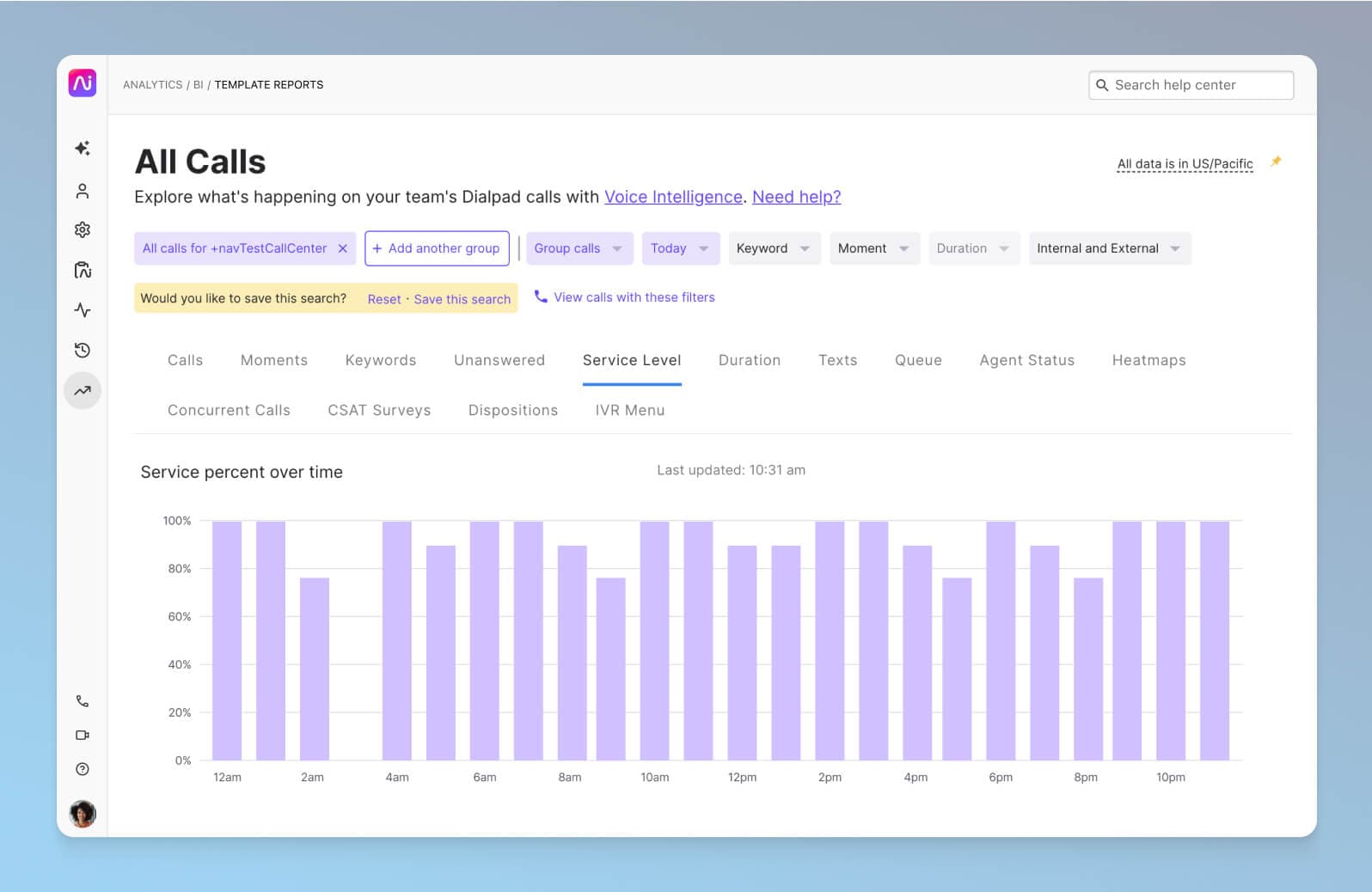
In Dialpad, you can see real-time information on call center metrics and KPIs, all in an organized dashboard. If I wanted to dig into why we’re not answering inbound calls quickly enough, for instance, I might look at our call volume patterns and see if it’s correlated with our speed to answer:
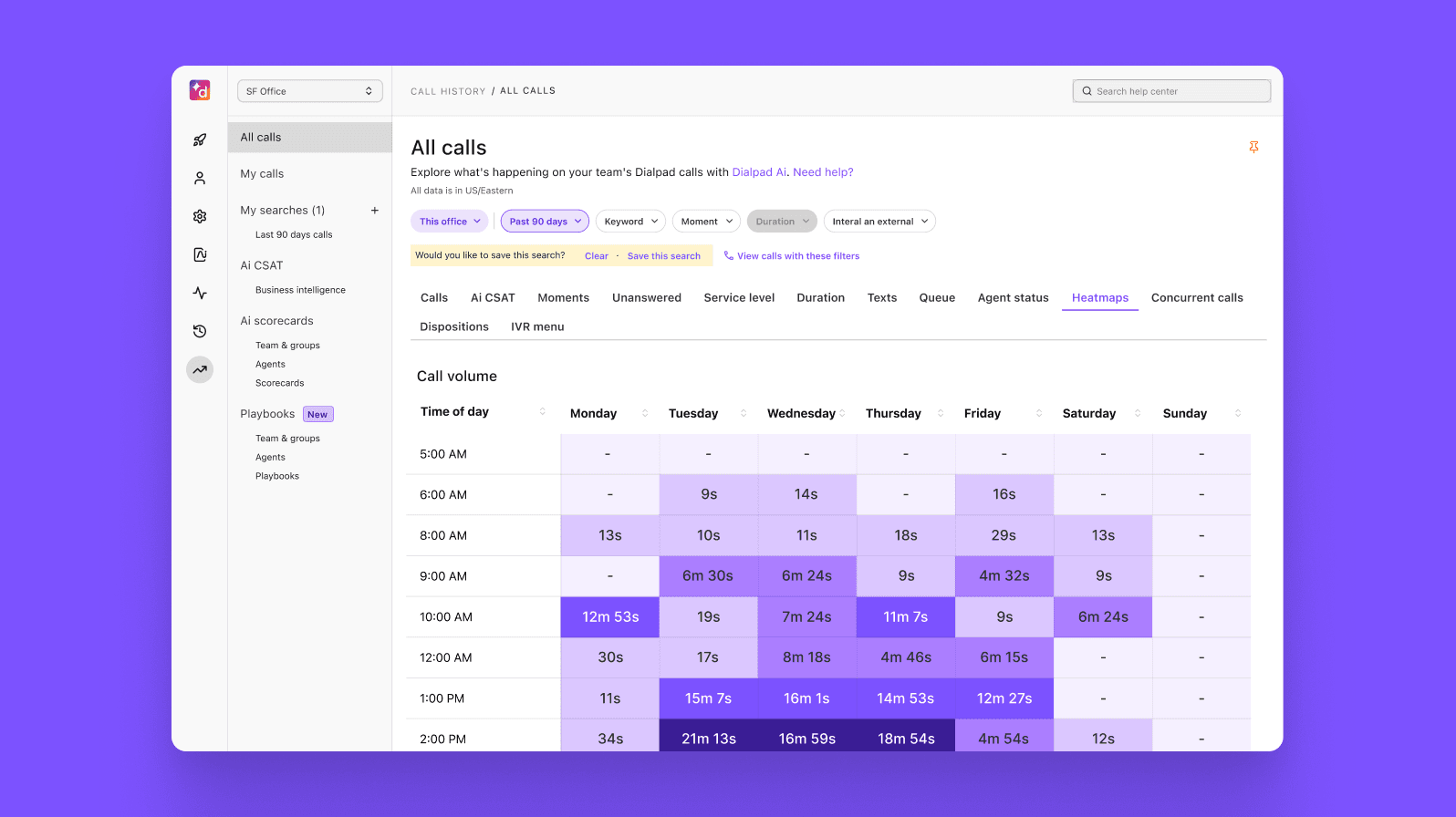
How to calculate your service level
To find out how your call center is performing, you can calculate a certain service level metric against a period of time. with this service level calculation:
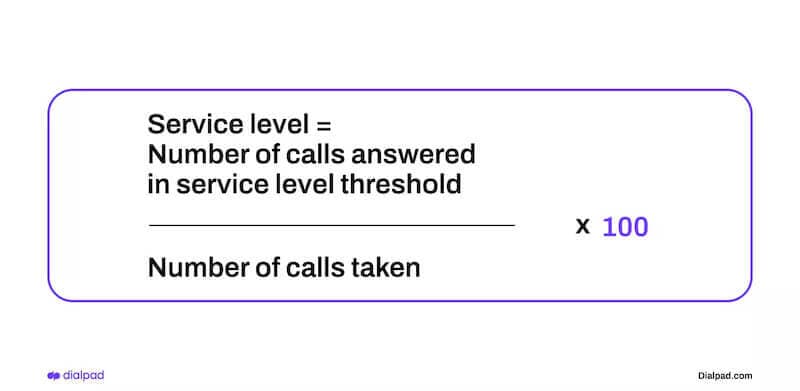
Calculating the service level of your call center is important as it will help you measure overall performance, as well as giving you information on the effectiveness of your call center strategy.
👉Dialpad tip:
Calculating the service level of your call center is a great way to see how effective your strategy is, but looking for the initial data can be time-consuming. Dialpad has a handy ‘call center alert’ feature available from the dashboard that gives users a clear overview of their overall service level (calls answered and service level threshold).
Industry standards for service level
Understanding some of the most popular industry standards for service level is an easy and effective way of benchmarking your own results.
Your individual service level goals will differ depending on your sector or what exactly you’re looking to achieve, but the most common SLAs in the industry include:
The 80/20 rule
For many years now, many contact centers in the industry have aimed to achieve the “80/20” rule when it comes to answering calls.
This service level target focuses on trying to answer at least 80% of incoming calls in under 20 seconds, though there are two slightly different approaches to this KPI: boosted service level and the relaxed answer time route.
Today, I’d say it's more of a guideline or baseline, rather than the actual “rule.” A better metric to monitor is your CSAT (customer satisfaction score) to understand your customer tolerance levels.
For example, if your CSAT goes down but you’re hitting your SLAs, that means you need to do some tweaking because your SLAs aren’t acceptable! SLAs are a constant temperance and adjustment—a living project if you will.
Boosted service level
While some centers have chosen to relax their SLA time, others may decide to boost their service level instead. Simply put, boosting your service level means upping the number of calls your agents take on and responding as promptly as possible.
When staffing, these contact centers will likely offset their SLA against their abandon rates to form their own “abandon ceiling,” based on individual CSAT and call abandon rates.
This might be a more beneficial route to take than a relaxed answer time as it puts more emphasis on the customer experience, handling and managing calls depending on individual metrics.
To put this into action, you might balance out your call center’s wait times differently, using your CSAT and abandon rates to make a better-informed decision.
To increase the number of calls you’re taking, you might start thinking about onboarding new hires to boost your service level—but this won’t automatically lead to happier and more satisfied customers.
It’s key that your customers connect with an agent who understands their problems and questions in detail.
Luckily, Dialpad Support has a built-in skills-based call routing feature. So, we can redirect calls to the best agents easily and make changes to the routing—on our own, in seconds.
In my experience, skills-based routing is a win-win-win. It’s better for callers, better for agents, and better for the call center as a whole. What’s not to like?
Relaxed answer time
Though the typical industry standard for calls answered comes under the 80/20 rule, there are those who are happy to remain below that line.
In some cases, contact centers will aim for anywhere between 70/20 and 80/60.
You might be wondering what kind of benefit could come out of relaxing your answer time. The answer is simple: reduced costs.
While the amount of time it takes to answer calls will have an impact on customer service, a more relaxed approach will also lend itself well to costs and staffing.
If you’re going for the relaxed answer time route, you’ll need fewer agents, meaning you’ll have lower costs overall when it comes to staffing.
If you do decide to take this route, however, it’s important to take into consideration your own CSAT and abandon rates to make sure your customer service rates don’t drop as a result. (Learn more about different customer service techniques.)
Abandon rate
Defined as the proportion of calls abandoned by a customer while on hold, abandon rates are another easy way to look into whether your customer service is effective or not.
The International Finance Corporation (IFC) currently places the global average for dropped calls at levels between 5% and 8%.
If you see your abandon rate rising, it might be useful to look at ways you can improve your call handling and interaction with customers.
A simple preventative measure could be tracking calls in real-time and overseeing interactions between customers and agents, either stepping in as an admin to take over or redirecting calls to more experienced agents.
This is something your call center software or cloud communications platform should be able to help measure. For example, Dialpad has a built-in “monitor all call centers” option that allows a contact center supervisor to track all active calls. You can use the sentiment analysis tracker here to get a better feel of how the conversations for every agent are going (and step in if it’s urgent):
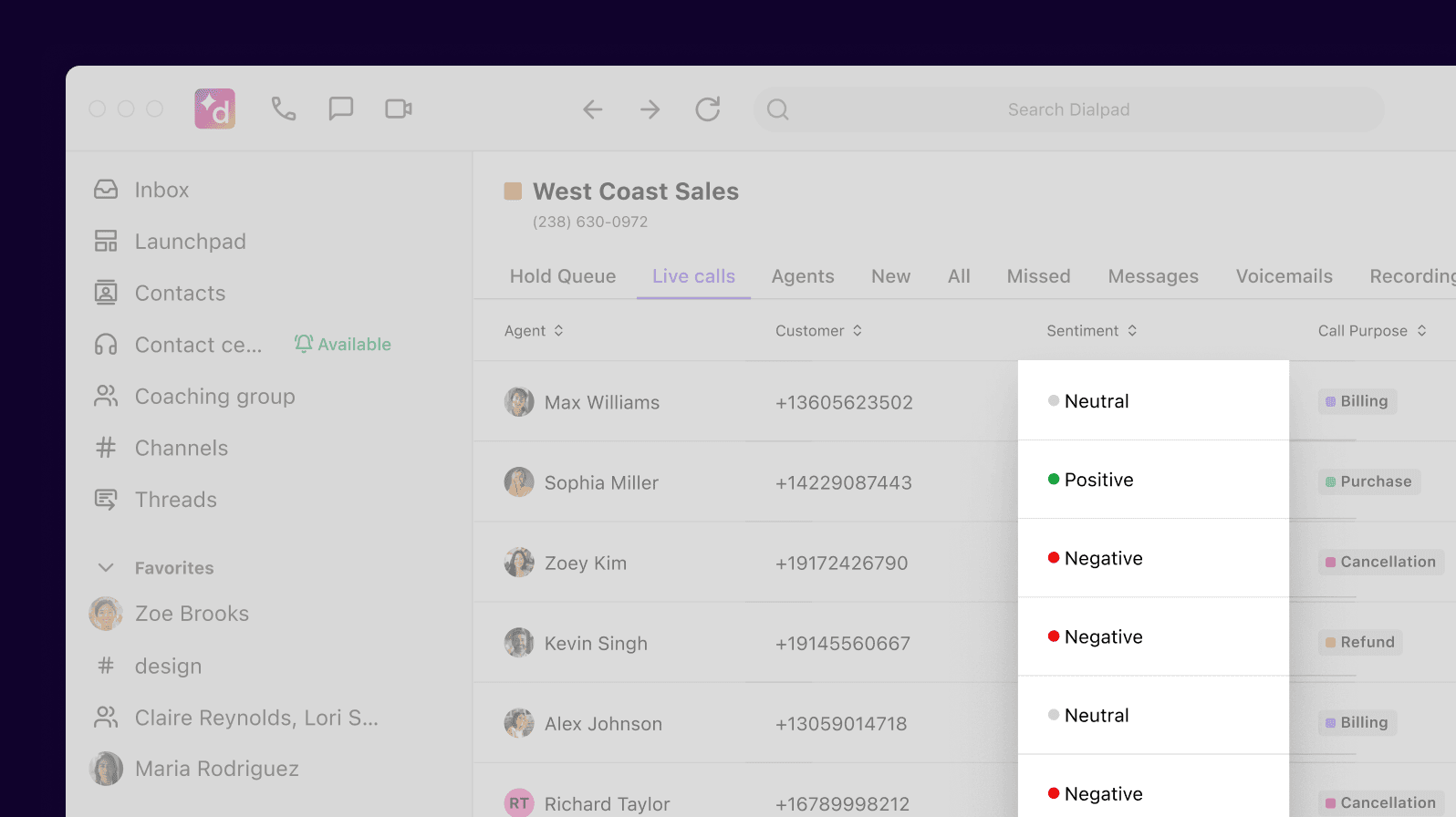
This is a good preventative measure for avoiding abandoned calls because you’re able to keep an eye on things and take action in real-time.
If you want to analyze your customer service from another angle, you could also look at your ASA (average speed of answer). With Dialpad, you’ll have access to these insights (along with other useful analytics) in your contact center dashboard:
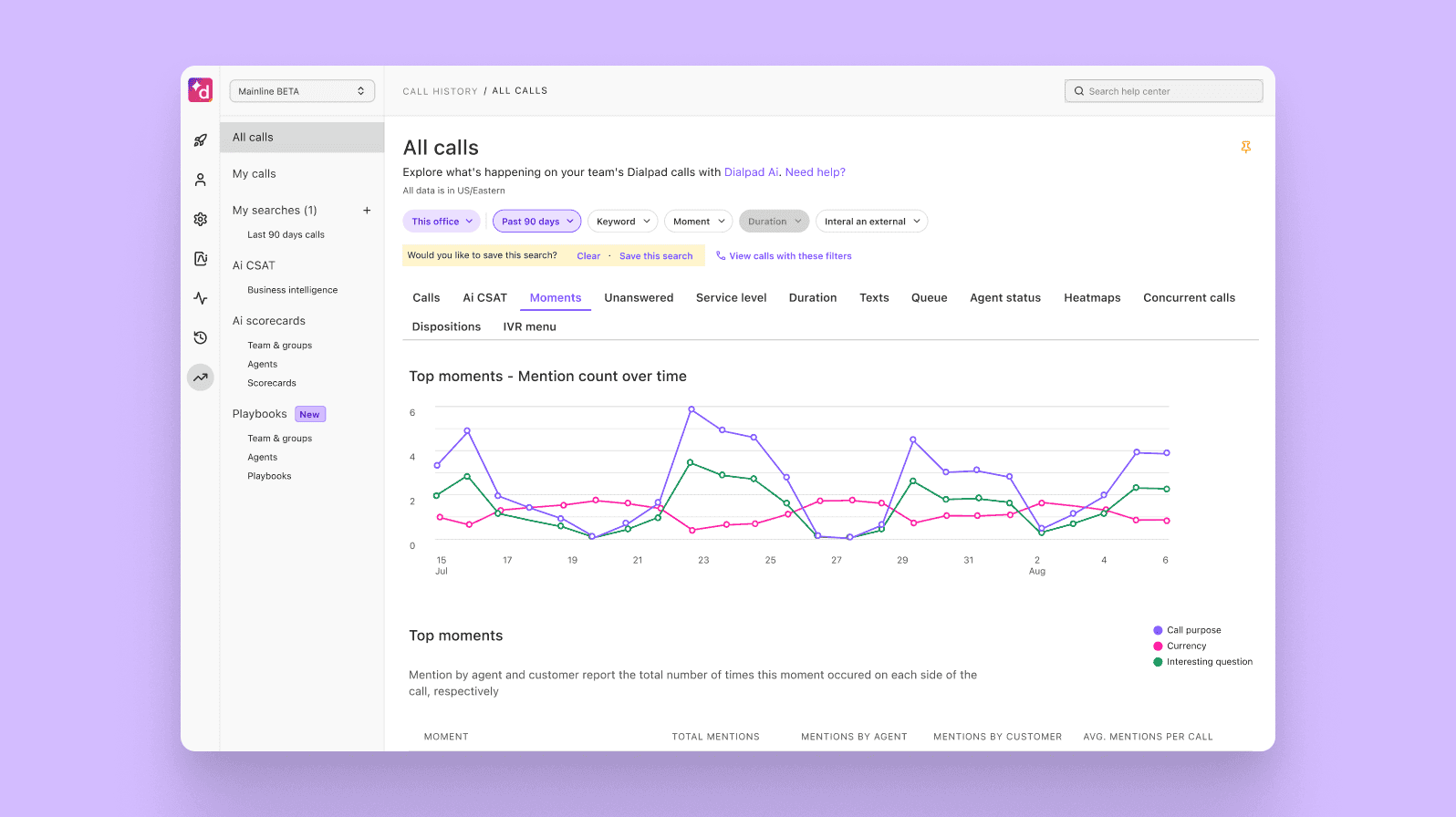
Other channels
Aside from these well known call SLAs, there’s also a variety of others related to non-call channels. Below are some of the most common industry standards for:
Answering emails
The standard service level agreement for answering emails lies between answering 90% to 100% of messages within 24 hours.
But, data does show that some contact centers wait up to 48 hours before responding. While that doesn’t necessarily sound like a long period of time, it isn’t exactly the best strategy out there.
Speedy, timely responses are what will bump up customer satisfaction and improve your service level.
Examining your own abandon rates via your email channel might not do much for establishing a service level, but it is useful for understanding where you might need to change a few things around.
If a lot of people are abandoning email for a different channel because of a long wait time, this switch will have an impact on both your call volume and customer experience.
Though most call centers stick to the 90 to 100% rule of emails being answered in under 24 hours, more and more are starting to answer queries in under four hours.
In the end though, it’s really up to what your customers expect from you.
👉Dialpad tip:
If you can give your customers self-service options, do it! Having a thorough Help Center with FAQ articles on your website can go a long way in helping your customers find answers to basic questions on your own—which frees up your agents to tackle the more complicated questions that require human intervention. Don’t overlook self-service—it’s a key component in many healthy contact centers!
Live chat handling
It’s important to note that unlike email and phone, live chat handling is a newer channel of communication, so compiling an average SLA becomes a little trickier.
To make things easier, some contact centers and call centers apply the 80/20 rule to live chats too. (Is that the best approach? Jury's still out on that.)
Since live chat is essentially a written channel but in real-time, most customers do expect a speedy response, similar to the phone experience.
When examining your own service level for live chat handling and responses, try to aim for as fast a response as possible. Just remember not to shoot for overly fast response times at the expense of the quality of the interaction.
Your customer support team shouldn’t need to feel like they have to handle multiple chats at once.
While some contact centers do this, you might find that your agents struggle to cope with more than three chats at a time—something that'll have a direct impact on both their mood and how effectively they respond to customer queries.
👉Dialpad tip:
If you’re looking for a cloud communication platform to boost your call center service level across live chat and phone calls, check out Dialpad Support, which makes your agents' lives easier because they can both message and have phone calls with customers—in the same platform!
Social media responses
The graph below shows a great variety in the time it takes for contact centers to respond to customers via their social media platforms.(The general consensus does seem to lean toward responding to 100% of customer queries on social media within an hour.)
The variance in response times is likely down to individual approaches to social media by contact centers. Some might feel that the channel is important because it targets a wider audience, while others might see it as a less formal channel.
When it comes down to your own social media response time, it’s key to take into consideration whether you’re a center that wants to be renowned for speedy customer service—or whether you view yourself as more of a "cost center."
If you label yourself as the latter, you might feel justified in slower response times, but if you pride yourself on excellent CX then speedy responses are a given.
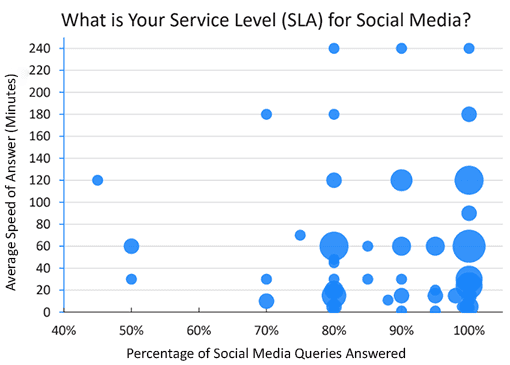
Some contact centers that aim for speedy response times are actually less concerned with answering customers directly and more interested in responding to negative comments and posts. Why?
Well, since negative customer reviews and comments have an impact on other potential customers’ buying decisions, it makes sense that companies would want to address this as quickly as possible.
SMS
The SLA for SMS interactions is a little tricky to define because again it's a newer channel, so it's really up to your customers' expectations. Generally, responding to 80% of messages within 40 seconds is a good initial target to shoot for as a call center.
Improve quality and performance by monitoring call center service level
By looking at industry standards for call center service level, you’ll be able to get a hold of what your own response times look like compared to the average.
Though it’s true that each contact center has its individual objectives, capacity, and workforce management (WFM) style, (meaning that your service level and response times might be different) it’s important to try to keep your replies as speedy as possible.
The right service level may be down to your center’s style and way of working, but the customer experience should be just as important to you as your costs, so aim for fast response times.
Whether you’re a center manager or part of a much wider team on the floor, the overall performance of your call center will also rely heavily on the systems you use. It’s all well and good that you aim to reply speedily, but if your systems don’t have enough capacity or channels then you might fall behind.
This is especially important if your center operates on a hybrid basis or remotely—agents that WFH may need special equipment and communications platforms to keep them properly connected and in the loop.
Improve your contact center's performance now
Looking for ways to improve your contact or contact center’s overall performance with real-time dashboards, ACD, IVR, skill-based routing, and call center analytics? Book a demo, or take a self-guided interactive tour of the app on your own!
